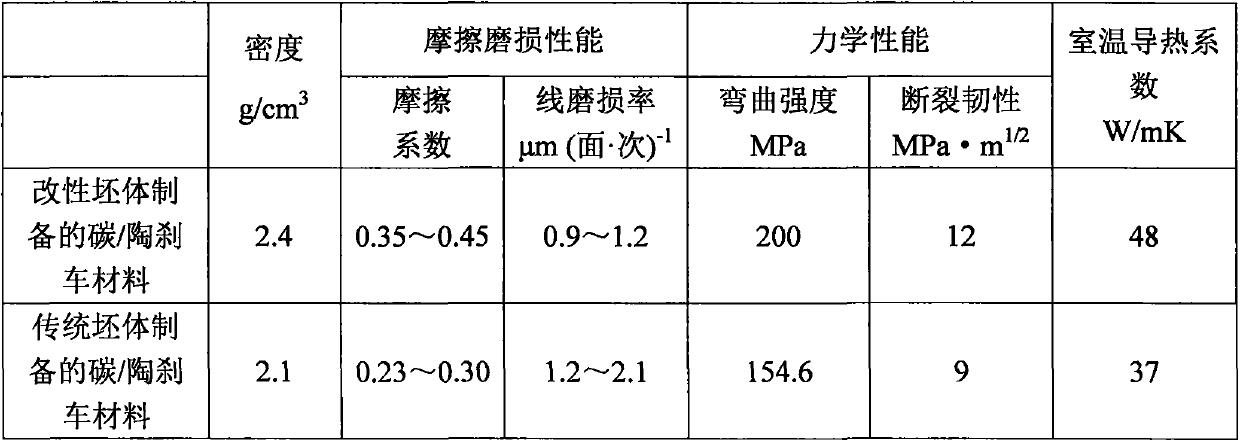High-speed train carbon ceramic braking material manufacturing method
The technology of a brake material and manufacturing method, which is applied in the manufacture of carbon ceramic brake materials, can solve the problems of small amount of Ti3SiC2 and uneven distribution, and achieve the effects of improving friction and wear energy, simple process, and improving thermal conductivity
- Summary
- Abstract
- Description
- Claims
- Application Information
AI Technical Summary
Problems solved by technology
Method used
Image
Examples
Embodiment 1
[0024] Step 1, preparation of carbon fiber preform
[0025] Several layers of single-layer 0° non-weft cloth, tire mesh, 90° non-weft cloth, and tire mesh are superimposed in sequence to a thickness of 35mm, and the required carbon fiber prefabricated body is prepared by relay needling; the needling density is 25 needles / cm 2 , with a bulk density of ~0.4g / cm 3 , wherein the volume ratio of the tire mesh layer to the non-weft layer is about 1:1.
[0026] Step 2, Ti 3 SiC 2 Preparation of slurry
[0027] First take by weighing 110g of sodium carboxymethylcellulose (CMC) and dissolve it in 10kg of water to prepare a 1% sodium carboxymethylcellulose aqueous solution with a mass fraction. Weigh 8 kg of Ti with a particle size of ~2 μm 3 SiC 2 , adding 10kg mass fraction of 1% sodium carboxymethyl cellulose aqueous solution, ball milling for 48 hours to prepare Ti 3 SiC 2 Ti with a mass fraction of 44% 3 SiC 2 Slurry, adjust the pH value to 10.
[0028] Step 3, with Ti...
Embodiment 2
[0038] Step 1, preparation of carbon fiber preform
[0039] Several layers of single-layer 0° no-weft cloth, tire mesh, 90° no-weft cloth, and tire mesh are superimposed in sequence to a thickness of 35mm, and the required carbon fiber prefabricated body is prepared by relay needling; the needling density is 30 needles / cm 2 , with a bulk density of ~0.5g / cm 3 , wherein the volume ratio of the tire mesh layer to the non-weft layer is about 1:2.
[0040] Step 2, Ti 3 SiC 2 Preparation of slurry
[0041] First take by weighing 50g of sodium carboxymethyl cellulose and dissolve in 10kg of water to prepare a 0.5% sodium carboxymethyl cellulose aqueous solution. Weigh 10kg of Ti with a particle size of ~0.5μm 3 SiC 2 , adding 10kg mass fraction of 0.5% sodium carboxymethyl cellulose aqueous solution, ball milled for 48 hours to prepare Ti 3 SiC 2 Ti with a mass fraction of 50% 3 SiC 2 Slurry, adjust the pH value to 11.
[0042] Step 3, with Ti 3 SiC 2 Preparation of c...
Embodiment 3
[0052] Step 1, preparation of carbon fiber preform
[0053] Several layers of single-layer 0° no-weft cloth, tire mesh, 90° no-weft cloth, and tire mesh are superimposed in sequence to a thickness of 35mm, and the required carbon fiber prefabricated body is prepared by relay needling; the needling density is 30 needles / cm 2 , with a bulk density of ~0.55g / cm 3 , wherein the volume ratio of the tire mesh layer to the non-weft layer is about 1:3.
[0054] Step 2, Ti 3 SiC 2 Preparation of slurry
[0055] First take by weighing 110g of sodium carboxymethyl cellulose and dissolve in 10kg of water to prepare a 1% sodium carboxymethyl cellulose aqueous solution with a mass fraction. Weigh 12kg of Ti with a particle size of ~1μm 3 SiC 2 , adding 10kg mass fraction of 1% sodium carboxymethyl cellulose aqueous solution, ball milling for 48 hours to prepare Ti 3 SiC 2 Ti with a mass fraction of 55% 3 SiC 2 Slurry, adjust the pH value to 11.
[0056] Step 3, with Ti 3 SiC ...
PUM
| Property | Measurement | Unit |
|---|---|---|
| density | aaaaa | aaaaa |
| density | aaaaa | aaaaa |
| density | aaaaa | aaaaa |
Abstract
Description
Claims
Application Information
 Login to View More
Login to View More - R&D
- Intellectual Property
- Life Sciences
- Materials
- Tech Scout
- Unparalleled Data Quality
- Higher Quality Content
- 60% Fewer Hallucinations
Browse by: Latest US Patents, China's latest patents, Technical Efficacy Thesaurus, Application Domain, Technology Topic, Popular Technical Reports.
© 2025 PatSnap. All rights reserved.Legal|Privacy policy|Modern Slavery Act Transparency Statement|Sitemap|About US| Contact US: help@patsnap.com

